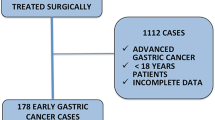Abstract
In Japan, gastric cancer is the primary cause of death in both males and females. Among early gastric cancers, the elevated lesion is almost always the differentiated type, whereas almost half of the depressed lesions are undifferentiated types. As for advanced gastric cancer, the differentiated type tends to grow expansively as in Borrmann I and II. In contrast, the undifferentiated type is an invasive lesion as in Borrmann III and IV, and preferentially metastasizes to both the peritoneum and regional lymph nodes. Both peritoneal dissemination and lymph node metastasis are more frequently noticed in younger patients than in older patients. The standard operation performed for gastric cancer in Japan is usually gastric resection including complete dissection of group II lymph nodes, which are found along the left gastric and common hepatic arteries, and around the celiac artery. Apart from lymph node metastasis, an important factor influencing the long-term result of surgery is serosal invasion. In order to improve long-term results, more aggressive lymph node dissection as well as effective management of the peritoneal invasion should be mandatory. Although there is no therapy superior to that of surgery for gastric cancer, it should be stressed that this malignancy should be treated with an appropriate combination of therapies.
Résumé
Au Japon le cancer de l'estomac représente la cause la plus fréquente de la mort chez l'homme et chez la femme. Parmi les cancers gastriques précoces, la lésion surélevée répond presque toujours à un type différencié alors que la lésion déprimée répond presque toujours à un type indifférencié. Quant au cancer gastrique évolué de type différencié, il tend à s'étendre largement en surface (Borrmann I et II). En revanche, ce même type de cancer, lorsqu'il est indifférencié, se présente comme une lésion invasive (Borrmann III et IV) et donne des métastases péritonéales et ganglionnaires régionales. Ce type de dissémination se voit particulièrement chez le sujet jeune. L'opération standard pour cancer de l'estomac pratiqué au Japon consiste habituellement en las résection de l'estomac et la dissection complète des ganglions lymphatiques du groupe II qui sont situés le long de l'artère coronaire stomachique, des artères hépatiques et autour du tronc coeliaque. En dehors de l'extension ganglionnaire l'un des facteurs les plus importants qui influe sur le pronostic à long terme est l'invasion de la séreuse. L'espoir d'améliorer les résultats réside donc dans une attitude très agressive aussi bien vis à vis des ganglions que de l'invasion de la séreuse péritonéale. Bien qu'il n'y aie pas de traitement supérieur à la chirurgie pour s'attaquer au cancer de l'estomac, l'auteur souligne la nécessité d'employer toutes les combinaisons thérapeutiques possibles pour essayer d'obtenir de meilleurs résultats.
Resumen
En el Japón el cáncer gástrico es la primera causa de muerte tanto en los hombres como en las mujeres. Entre los cánceres gástricos tempranos, las lesiones elevadas (que protruyen) son casi siempre del tipo diferenciado, en tanto que casi todas las del tipo indiferenciado aparecen deprimidas (o excavadas). En cuanto a los cánceres gástricos avanzados, las de tipo diferenciado tienden a crecer en forma expansiva como en las clases Borrman I y II. En contraste, las de tipo indiferenciado son lesiones invasivas como en las clases Borrman III y IV y preferencialmente hacen metástasis al peritoneo y a los ganglios linfáticos regionales. Tanto la diseminación Peritoneal como las metástasis ganglionares son observadas con mayor frecuencia en pacientes jóvenes que en pacientes de edad avanzada. La operatión estandar para cáncer gástrico en el Japón usualmente es la resección gástrica con disección completa del grupo II de los ganglios linfáticos, o sea aquellos ubicados sobre el trayecto de las arterias gástrica izquierda y hepática común y alrededor del tronco celiaco. Aparte del estado de los ganglios linfáticos, un factor de importancia en la supervivencia a largo plazo después de la cirugía es la invasión de la serosa. Con el objeto de mejorar los resultados a largo plazo, aparece mandatorio el realizar una disección ganglionar más agresiva así como un manejo más efectivo de la invasión peritoneal. Aunque no existe una terapia superior a la cirugía para el cáncer gástrico, debo hacer énfasis en que el cáncer debe ser tratado mediante una adecuada combinación de modalidades terapéuticas.
Similar content being viewed by others
References
Nakamura, K.: Structure of the Gastric Cancer, Tokyo, Igaku-Shoin, 1982
Sakamoto, K.: Clinicopathological study on the metastatic mode of gastric cancer. Jpn. J. Surg. (in press)
Fielding, J.W.L., Roginski, C.: Clinicopathological staging of gastric cancer. Br. J. Surg.71:677, 1984
Kajitani, T., Miwa, K.: WHO-CC Monograph No. 2, Treatment Result of Stomach Carcinoma in Japan, Tokyo, National Cancer Center Press, 1979
Nakajima, T., Kajitani, T.: Surgical treatment of gastric cancer with special reference to lymph node dissection. In Proc. Int. Cong. Diagnosis and Treatment of Upper Gastrointestinal Tumors, Amsterdam, Elsevier, Excerpta Medica, 1980, pp. 207–223
Japan Research Society for Gastric Cancer: The General Rules for the Gastric Cancer Study in Surgery and Pathology, 2nd edition, Tokyo, Kanehara Shuppan, 1985
Takeshita, K., Habu, H.: A long-term post-operative results of early gastric cancer. Jpn. J. Surg.81:724, 1980
Takemura, K., Hirayama, R.: Distribution of lymphocyte subsets in gastric cancer and its regional lymph nodes. Jpn. J. Gastroenterol. Surg.19:849, 1986
Vissali, J.A., Grimes, O.F.: An embryological and anatomical approach to the treatment of gastric cancer. Surg. Gynecol. Obstet.103:154, 1971
Author information
Authors and Affiliations
Rights and permissions
About this article
Cite this article
Mishima, Y., Hirayama, R. The role of lymph node surgery in gastric cancer. World J. Surg. 11, 406–411 (1987). https://doi.org/10.1007/BF01655802
Issue Date:
DOI: https://doi.org/10.1007/BF01655802




